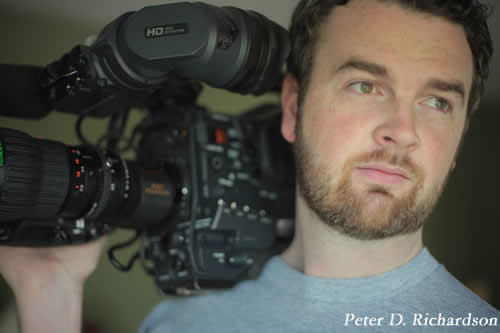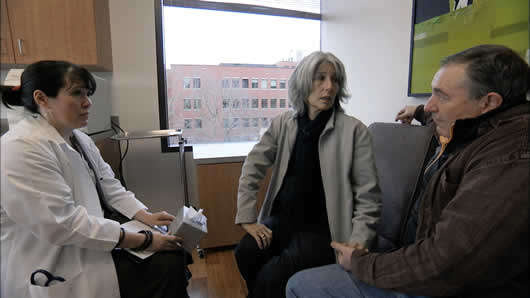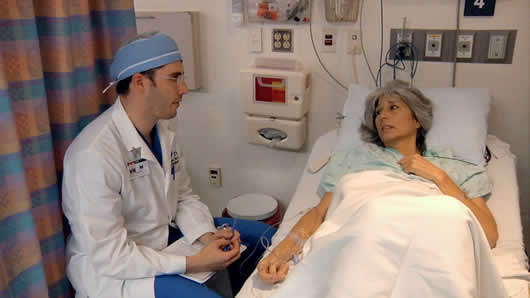 How to Die In Oregon is an extraordinarily powerful, compassionate and intimate exploration of Oregan’s historic and controversial Death with Dignity Act, which legalizes physician aid-in- dying for some terminally ill patients. Since Oregon became the first state in the nation to pass such a law in 1994, more than 500 Oregonians have taken advantage of it. Sagner was the 343rd, and he is one of a half-dozen terminally ill people whom filmmaker Peter Richardson (“Clear Cut: The Story Of Philomath, Oregon”) follows as they struggle with whether, and when to end their lives by lethal overdose.
How to Die In Oregon is an extraordinarily powerful, compassionate and intimate exploration of Oregan’s historic and controversial Death with Dignity Act, which legalizes physician aid-in- dying for some terminally ill patients. Since Oregon became the first state in the nation to pass such a law in 1994, more than 500 Oregonians have taken advantage of it. Sagner was the 343rd, and he is one of a half-dozen terminally ill people whom filmmaker Peter Richardson (“Clear Cut: The Story Of Philomath, Oregon”) follows as they struggle with whether, and when to end their lives by lethal overdose.
Bijan Tehrani: How did you first encounter the subject for How to Die in Oregon, and how did you decide to make a film about it?
Peter D. Richardson: I lived most of my life in Oregon, so I was kind of close to this subject in that respect and the actual inspiration of the film came through a strange coincidence. I had just finished my first film, called Clear Cut, which was actually a film about my hometown. Because of that film, I got into Sundance and the day that I was leaving for the festival, it happened to be the day that the Supreme Court ruling upholding Oregon’s law was announced. The Bush administration challenged the law and ultimately the Supreme Court upheld the decision. I was quite literally leaving my hotel room that morning and I saw in the newspaper in the hotel. I read the headline about the ruling on the death with dignity law and I knew from that moment that this would be the next film I would make.
BT: What it a hard decision to jump into a topic like this?
PR: It was a hard decision; from 2006 and the following eleven months I was on the festival circuit with Clear Cut and I was constantly thinking about what my next film would be. There was a lot of trepidation and reluctance to get into a topic that was difficult and personal. I was really focused on the stories of individuals who have a terminal diagnosis and are considering using this law to their advantage. I knew that this film would entail several years of work, and that some of my subjects would not be with us by the time the film was  completed. At the end of my festival circuit it was clear to me that, despite the difficulties, that this was really the film I needed to make and it was an important issue. It was February 2007 when I actually started with the first meeting and talking to the people that you see in the film. I looked at other films that other documentary filmmakers had made and noted the extremely difficult circumstances; some films require a whole new level of courage and devotion toward a subject, so I embraced the challenge and decided that this was what I wanted to do.
completed. At the end of my festival circuit it was clear to me that, despite the difficulties, that this was really the film I needed to make and it was an important issue. It was February 2007 when I actually started with the first meeting and talking to the people that you see in the film. I looked at other films that other documentary filmmakers had made and noted the extremely difficult circumstances; some films require a whole new level of courage and devotion toward a subject, so I embraced the challenge and decided that this was what I wanted to do.
BT: With your topic, it was important to convey the emotional and physical pain that drives these people to the decision to end their own lives. How did you go about revealing this struggle and how people come to this point?
PR: Yeah, that was definitely one of the challenges that I faced while making the film. I wanted to make it clear to the audience why someone would want to make this kind of decision; the pain that they might be going through. At the same time, in order to show that, we needed a great deal of intimacy and access with our subjects. If a person dealing with great pain and suffering, that can be a very personal and private moment. With so many people in the film, I didn’t know if I would have access to some of those more difficult times, and that was one of the challenges in the film. Fortunately, when I met Cody Curtis, she became more open to allowing me to see those personal moments and everything she went through, including her surgery. I actually encountered situations in which I questioned what I was doing. I was trying to show that this person is going through quite a lot of suffering, but I didn’t want to cross the line by showing graphic surgery if it didn’t have a place in the film—I had to have an ethical balance. The scene that was the most challenging for me to film was after Cody went to her former workplace and received an award. She returned home and just broke down emotionally—I was going to put the camera down, but felt compelled to continue to film. Every fiber of my being was telling me to put the camera down because the last thing you want to do when someone is having a breakdown is to film them. I knew, however, that if I put the camera down it would downplay the great internal anguish that Cody was going through— of course, if she told me to stop, I would have put the camera down. I hope that there is a delicate balance between intimacy and telling someone’s story, because that is what I was aiming for.
 BT: Even though the film centers on a tragic subject, you managed to bring positive feelings into How to Die in Oregon? . Can you tell us how you created the mood in your film?
BT: Even though the film centers on a tragic subject, you managed to bring positive feelings into How to Die in Oregon? . Can you tell us how you created the mood in your film?
PR: I worked closely with Greg Snider, my editor, and we really clicked and it positively effected how we edited the scenes. I had filmed every scene personally, so I was aware of the spirit of every scene—I even remembered what kind of day I was having in our raw footage. I think what Greg and I realized in the editing room was that we knew that this film was going to be a sad film because, of course, there is sadness when someone die—especially when that person dies at a young age because of a terminal illness. There is sadness, but there is also a remarkable amount of courage and happiness to show. How the character approaches her own life and the time that she has left is very inspiring; those were the ideas that we talked about that were sad, but not depressing; tragic, but also life affirming. We needed to include true stories of these people and the way that they approach life. There is a large amount of grace and bravery, even through tragedy. When I watched the film with Greg, I was proud of the emotional scenes that still conveyed positive feelings, like when Cody was giving some of her clothes away to her friends; it was a happy day, and we captured that sense of life.
BT: How has the audience reaction been to How to Die In Oregon?
PR: There is obviously a lot that has been written about it, and I certainly had some trepidation of people seeing the film because it has been portrayed as some unflinching view of people dying. However, I’ve felt that people are struck at how life affirming the film is and how much humor there is—there is a lot of sadness, but there is a lot of laughter as  well. I think that people will say that it was a hard film to watch, but they are very glad that they went to see it. We are afraid to talk about death, and this can be a scary movie, but it’s also compassionate movie and even, in a way, kind of a love story. The film shows that people are hungry for a real, open and honest conversation about assisted suicide. In our culture, it has been moved from the home to the hospitals and sequestered out of our daily lives. I hope that people are open to this conversation and I know that it takes some courage to watch this film.
well. I think that people will say that it was a hard film to watch, but they are very glad that they went to see it. We are afraid to talk about death, and this can be a scary movie, but it’s also compassionate movie and even, in a way, kind of a love story. The film shows that people are hungry for a real, open and honest conversation about assisted suicide. In our culture, it has been moved from the home to the hospitals and sequestered out of our daily lives. I hope that people are open to this conversation and I know that it takes some courage to watch this film.
BT: Do you have any films lined up for the future?
PR: I’m not sure yet. I have a few ideas brewing, but nothing that I have settled on yet.
BT: Thanks for spending time with us to discuss this emotional and important film. Good luck with How to Die in Oregon, and your future endeavors as well!
How To Die In Oregon will run on HBO throughout the month of May/June (premieres on May 26th)

